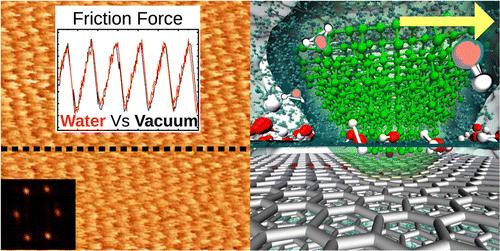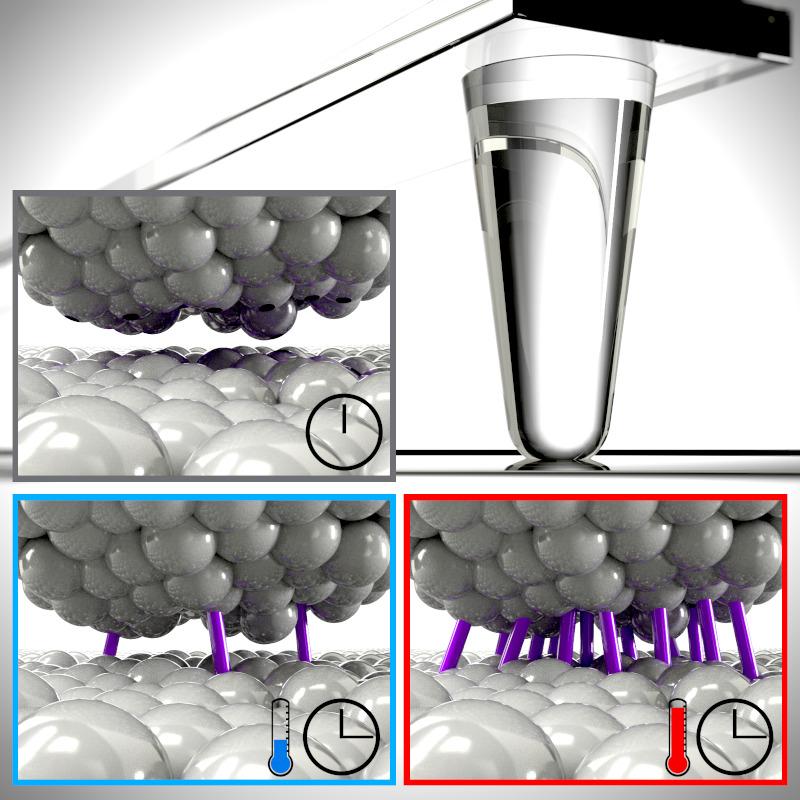Friction is a phenomenon that is in our everyday life although we tend to remember it only when it is nearly absent such as in the comical popular staple of slipping on a banana peel. Its presence across disparate length scales (earth-quakes, car engines down to molecular machines) reminds us of its ubiquity which endows friction of an utmost practical importance. Although attempts to control it are as old as civilization, a lack of fundamental understanding hinders our predictive power (e.g. it is impossible to know a priory friction coefficient for given contact). In a renewed attempt to control friction by atomistic design and aiming to bridge the gap across different length scales, the fields of nanotribology and nanomanipulation were established. In our group, we are particularly keen in understanding: how friction is affected by the surrounding environment; how the strength of a contact between two surfaces changes with time (contact aging) a process ultimately related to origins of static friction; if molecular internal degrees of freedom may be chemically engineered to control how energy is dissipated (friction) at single-molecule level.
Friction in liquids

Any macroscopic surface exhibits a significant roughness thus leading to a certain number of true contact points at the interface. In this regard, atomic force microscopy (AFM), where a sharp tip is elastically driven on a solid substrate whilst measuring the associated friction, stands out as a tool of excellence in tribology. Despite its undisputed success, data interpretation in liquid and in ambient conditions is far from straightforward. In particular, it is unclear what is the role played by the solvent during sliding (e.g. if it is trapped under/around the tip), as well as other effects such as capillary condensation and presence of contaminants. We have shown that on a hydrophobic surface such as graphene, water molecules will mask these effects allowing us to recover the high resolution usually attained in much more elaborate Ultra-High-Vacuum (UHV) setups. The trick is that the tip is able to brake the surface hydration layer at relatively low forces giving rise to a direct tip-surface contact in a similar fashion as in UHV experiments. Importantly, we have also shown that collisions of water molecules with the tip only contribute as white noise to the measured forces. Now … is this the end of the story? What if the interaction between the solvent and tip/surface can be made stronger than the weak water hydrophobic-surface interactions? Or even … can the nature of the solvent (polar, apolar, ionic, …) help us to modulate friction even in a direct contact such as the one shown above? These and other questions are now driving our research in this front.
Want to learn more?
Atomic-Scale Sliding Friction on Graphene in Water.
J. G. Vilhena, et al. ACS nano 10(4), 4288 (2016). [link: https://doi.org/10.1021/acsnano.5b07825]
Contact ageing
Contact ageing

Around 350 A.D. the Greek philosopher Themistius reported that “One may more easily further the motion of a moving slider than to move a body at rest.” Despite the importance of this phenomena involved in a manifold of processes from earthquake dynamics down to microelectromechanics, our understanding of the atomistic origins governing it is rather limited. In this regard, some enlightenment is brought with the concept of contact aging, a process by which the strength between two adjacent materials (e.g. surface and slider) strengths with the hold time. Aging can be categorized into two different processes: quantitative and qualitative aging. The former, an established and widely accepted mechanism, describes the time-dependent increase of the real contact area due to plastic deformation and material creep. The latter, i.e. qualitative aging, is a process by which the strength per unit area changes with time as a result of interfacial chemistry (e.g. bond formation between the atoms of the surface and slider). In our group, we work in collaboration with several experimental groups to provide a live picture the dynamics of the atomic processes occurring at the interface. Recently, we have provided the first ever reported direct evidence linking contact aging to thermally activated bond formation (in a ultra-clean an controlled environment). Additionally, we observed that this atomic aging mechanism can stretch over timescales up to several seconds. This stepping stone, shed light on the distinction between contact “quantity” and “quality” thus paving new roads to a detailed understanding on the origins of the time dependence of static friction.
Want to learn more?
Temperature
Activates Contact Ageing in Silica Nanocontacts.
Matthias
Vorholzer*, J. G. Vilhena*, et al. Phys. Rev. X 9, 041045
(2019). [link: https://doi.org/10.1103/PhysRevX.9.041045]
Time
strengthening of crystal nanocontacts.
J. J. Mazo, et al.
Physical Review Letters 118 (24), 246101 (2017). [link:
https://doi.org/10.1103/PhysRevLett.118.246101]
Nanomanipulation & Cryo-force-spectroscopy

During the past decades we have witnessed a growing desire in miniaturization of devices down to the nanometer scale. Examples such as auto-assembling of molecular structures capable of meeting specific needs (e.g. synthetic photosynthesis, catalysis and molecular electronics) up to molecular-machines (2016 Nobel prize in Chemistry) are promising avenues with a huge technological and economic interest in the decades to come. “Special problems occur when things get small […] and it might turn out to be advantages if we knew how to design for them”, said Feynman when discussing the prospects of building “infinitesimal machinery”. In particular, designing for more efficient molecular “machinery” as well as for better on-surface processes of molecular auto-organization requires a more detailed understanding of friction at a molecular level and more generally how energy is dissipated in such systems. Here, we push the accuracy limits of general purpose all atom molecular dynamics simulations by combining them with state of the art QM calculations in order to build dedicated force-fields. In this way we not only have a predictive (without any ad-hock fitting parameters) and accurate description of state-of-art Low-Temperature UHV experiments (known as Cryo-force-spectroscopy) but we also provide a wealth of information concerning the internal dynamics molecules during lifting of sliding processes. Using this approach we achieved several breakthrough, namely: first measure of enthalpic stretching moduli of a single DNA nucleotide, real time detection of the rotation of a single C-C bond via an external mechanical stimuli and we were also able to exploit internal molecular degrees of freedom to induce non-linear motion (slithering) of molecular chains whilst maintaining a superlubric sliding (a property thus far restricted to hard contacts). Currently, we are working on how we may remotely control on-surface molecular motion via chemical design, and also a major effort is being devoted in unveiling how heat/energy is transferred/dissipated in molecular contacts.
Want to learn more?
Sequential
Bending and Twisting around C–C Single Bonds by Mechanical Lifting
of a Pre-Adsorbed Polymer.
Remy
Pawlak*, J. G. Vilhena* et al. Nano Letters 20 (1), 652
(2020). [link:
https://doi.org/10.1021/acs.nanolett.9b04418]
Conformation
And Mechanical Response of Spray Deposited Single Strand DNA on Gold.
Remy Pawlak*, J. G. Vilhena* et al. Nature
Communications 10 (1), 685 (2019). [link:
https://doi.org/10.1038/s41467-019-08531-4]
Stick-Slip
motion of ssDNA over graphene.
J. G. Vilhena
et al. Journal of Physical Chemistry B 122 , 840 (2018).
[link:
https://doi.org/10.1021/acs.jpcb.7b06952]